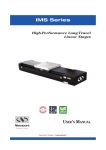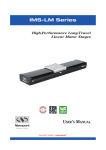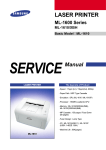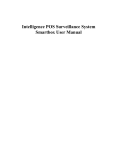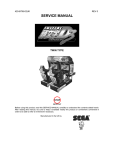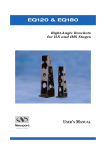Download Mercury IMS2500-24 User manual
Transcript
IMS150/300/600/1000/1500/2500 (12/24V) Modified Sine Wave Inverter User Manual IMPORTANT NOTICE: This product is not intended to be use by children or persons in poor health without supervision. Please read this manual thoroughly before use. CAUTION: Each model is design to work up to its maximum rated power load. Please check carefully to ensure applications used are within the rated power range. Any attempt of misuse to overload will trigger the overload protection and may cause damage to both unit and application used. Mercury will not be responsible for any damaged caused by misusage of the product WARNING Contain high voltage and high current! Do not open or attempt to repair yourself! This manual is written for below models: 652.000UK 652.001UK 652.002UK 652.003UK 652.004UK 652.005UK – – – – – – IMS150-12 IMS150-24 IMS300-12 IMS300-24 IMS600-12 IMS600-24 652.006UK 652.007UK 652.008UK 652.009UK 652.010UK 652.011UK – – – – – – IMS1000-12 IMS1000-24 IMS1500-12 IMS1500-24 IMS2500-12 IMS2500-24 INTRODUTION: Thank you for choosing this Modified Sine Wave Inverter. This inverter is capable of converting DC power input to AC power output that has similar output signal wave as normal domestic mains. Unlike pure sine wave inverters, modified sine wave inverter is not recommended for powering voltage sensitive or inductive equipment. For inductive load such as fluorescent light, acoustic equipment and equipment contain motor such as fan and compressor, we recommend to use our pure sine wave inverter instead. Below shows the differences in output voltage waveform between pure and modified output: PRODUCT LAYOUT: User Manual FRONT PANEL: - ON/OFF SWITCH – rocker switch to switch unit on and off - POWER INDICATOR – solid green LED indicates unit has been switched on - FAULT INDICATOR – solid on or flashing red LED indicates fault has occurred, refer to fault code for interpretation - USB POWER SOCKET – 5V 1.0A USB power supply socket for charging smart phone camera etc - UK AC MAINS SOCKET – output UK mains socket provide 230Vac 50Hz mains power - GROUND CONNECTION – star washer and nut for ground connection to the outer case (normally connected to the vehicle chassis) BACK PANEL: - INPUT BATTERY NEGATIVE CONNECTION – battery input connection to connect negative output of the DC power source - INPUT BATTERY POSITIVE CONNECTION – battery input connection to connect positive output of the DC power source - FUSES – location of the fuses - FAN DUCT –fan for cooling - do not obstruct Temperature and load controlled multi-speed cooling fan: The cooling fan is designed to run at a speed in proportion to the load, this minimises the running noise and extend fan life. - At load lower than 40% or inner temperature less than 30°C the fan will not operate - At load between 40% - 60% the fan will operate at 40% of its maximum speed - At load between 60% - 80% the fan will operate at 60% of its maximum speed - At load between 80% - 100% the fan will operate at 80% of its maximum speed - At 100% load or inner temperature exceeds 45°C the fan will operate at 100% of its maximum speed INSTALLATION: Location – it is important to for the location of the inverter to meet below requirements: - Dry environment where there should be no risk of the inverter coming into contact with water - A cool shaded environment where temperature should be 0°C – 40°C, not to be placed near any heat source and avoid direct sunlight - A well-ventilated area, minimum clearance of two inches should be allowed in front of the ventilation duct and fan. Please ensure free flow of air around the unit, if the unit is used to its full load, an external fan may be used to aid the cooling of the unit - Not to be place in the same compartment as the battery or together with flammable substances - Avoid dusty environments, dust can cause blockage of airflow within the inverter and cause the unit to overheat - Avoid using long input cable run as input voltage can be affected by cable resistance and heat User Manual Mounting – The unit should be mounted horizontally, we do not recommend mounting the unit vertically. Connection: - Please ensure the ON/OFF switch on the inverter is in the OFF position and the voltage of power source matches the required inverter input voltage, if the power source is from a DC power supply please ensure it is switched off also - Connect the invert to battery / DC power source. Using provided black cable; connect the black negative terminal to the negative output of the power source. Using provided red cable; connect the red positive terminal to the positive output of the power source. - Before connect the inverter to appliances please ensure the appliance power rating is within the inverter’s continuous output power. After connected, double check all connections are correct before switch on the inverter and appliance. If more than one appliance is being used on the same inverter, please ensure appliances are switched on one after the other, after the inverter has been switched on. This is to avoid the inverter undergoing any surge current from individual load all at once. Please beware, any use of cables and accessories other than the ones provided may cause damage, Mercury will not take any responsible for damage caused by use of third party accessories. For cable cross-section requirement for different models, please refer to accessory appendix at the back of this manual. Some models with higher power may have 2 pairs of terminals that require 2 pairs of cable to help with the high input current. ALWAYS ensure the correct polarity is connected before start, DO NOT reverse input polarity as it will blow up the fuse and may cause permanent damage to the inverter. Input power specification: For an inverter running from a battery, the duration of the appliance is determined by these 3 factors: - Voltage of input power - Power of the appliance - Capacity of the battery For example an appliance of 100W running on a 12V input power inverter will require: 100/12 = 8.33 Amp/hour A typical 12V car battery has capacity of around 80Ah; to run the above example on this battery we can estimate it will be capable of duration of: 80/8.33 = 9.6 hours In reality, this number will be lower due to the power lost from the efficiency in power conversion (in this case over 80% of DC power will be used to convert to AC power) power lost from the input/output cable, depreciation of battery capacity on older batteries, and temperature (a cold battery holds less capacity). User Manual For running the inverter on a DC power supply, it is important the check the current from power source is sufficient to run the inverter at full load. The required current to allow the inverter to operate at full load can be estimated from the continuous output power of the inverter and input power voltage. For example a 1500W 12V input inverter at maximum load will require input current of: 1500 / 12 = 125 Amp In reality the current requirement will be higher to compensate the power lost during the DC – AC conversion and the power lost from the cable. From the above calculation please choose your power source set up for the inverter carefully to suit the purpose of use in terms of both duration and load. The start-up load is also a major factor of whether the inverter is capable to power up the appliance. Although the start-up load peaks for a fraction of a second, the start-up load is normally twice as much as the rated continuous power of the appliance. In some equipment the start-up load can be as high as 8 times of its continuous power, especially on inductive loads that include an electric motor. This inverter can withstand the momentary start-up load for up to 2 times of its rated continuous output power for up to 2 seconds. To determine if the inverter is capable to start up an appliance, simply test it by plugging it in and running it. If the start-up current peaks higher than the highest power inverter can supply, it will trigger the over load protection, which creates a buzz and the fault LED indicator will light to indicate there is a fault. BATTERY ARRAY CONNECTION: To increase the duration of inverter operation while running on battery, multiple batteries can be linked together to increase the total capacity and duration. The below diagram shows the common ways to wire typical 12V 75Ah batteries together to increase the capacity for both 12V and 24V output: 12V OUTPUT – PARALLEL CONNECTION (voltage remains current increase) User Manual 24V OUTPUT – SERIES CONNECTION (voltage increase current remain) 24V OUTPUT – SERIES/PARALLEL CONNECTION (both voltage and current increase) SAFETY INSTRUCTION: Please note the following instructions should be carefully followed as any incorrect installation or misuse of the inverter may cause harm to user and damage apparatus. - Do not connect any other form of input power other than DC power that is within the inverter’s acceptance range - Ensure the ventilation duct on both front and back panels are clear of blockage when the inverter is in use - Please use appliance with power rated within the inverter power range. Do not attempt to overload the inverter constantly - Do not pull on cable when unplugging from the inverter, always grip firmly on the plug - To avoid shock hazard, always ensure inverter and DC power supply (if apply) are switched off before inserting the AC plug to the inverter - Strictly for indoor use only, avoid exposing the unit to any heat source, sunlight, dust, moisture or flammable substances - It is normal that the inverter will become hot while in use, please avoid touching the unit - Do not drop the inverter - Do not place any object on the inverter - Always connect/set up with cable and accessories supplied and follow the instructions carefully. Any use of third party accessories may cause damage and result in injury - Do not attempt to service or disassemble the inverter. Any attempt to do so can cause injury to user including death from exposure to high voltage. If problems are experienced from the unit User Manual when in use, please discontinue use immediately and contact technician or retailer - This inverter is design to be maintenance free, but requires occasional attention as dust may build up after period of time. To clean dust off, please switch off power from inverter and unplug AC plug. Carefully clean unit with a dry cloth. Do not use a wet cloth or cleaner - Check and tighten the DC input terminal on regular basis, as if the inverter is stored in an environment with a lot of vibration (eg in a vehicle) it may cause the hand screw to become loose - Keep out of reach of children PROTECTION FEATURES: This inverter has several protection features designed to protect the unit from failure and also to ensure the safety of user if the unit does fail. PROTECTION FEATURES INDICATION BUZZER FAULT LED Low input power protection warning Sound 2 times every 8 sec Flash 2 times every 8 sec Low input power protection critical Sound 3 times every 8 sec Flash 3 times every 8 sec Input over power protection Sound 4 times every 8 sec Flash 4 times every 8 sec Over heat protection Sound 5 times every 8 sec Flash 5 times every 8 sec Short circuit protection N/A Constant flash Over load protection N/A Constant flash Low input power protection warning – the input power is below 10.8V± 0.2V for 12V input inverter and 21.6V± 0.4V for 24V input inverter. This indicates the power bank is running low or DC power supply is insufficient, requires charging or boost of DC power supply. Low input power protection critical – the input power is below 10.2V± 0.2V for 12V input inverter and 20.4V± 0.4V for 24V input inverter. This indicates the power bank or DC power supply is critically low, to protect the battery and dc power supply from over drained, inverter will switch off AC output. Input over power protection - the input power is over 15.5.2V± 0.2V for 12V input inverter and 31V± 0.4V for 24V input inverter, the inverter will shut the output off to stop inverter from damage by the extra input power. Over heat protection – when inner temperature exceeds 45°C, temperature controlled fan will automatically switch on to try to cool down the unit. If unit can not be cooled down due to high ambient temperature or any other reason and inner temperature reaches 75°C, the inverter will automatically shut down the output to stop inner temperature creeping higher to cause damage to components. Short circuit protection – in case of short circuit occurs, AC output will be switched off to eliminate shock hazard to user. Over load protection – in case of overload occurs, AC output will be automatically switched off to protect inverter from damage. User Manual TROUBLESHOOTING REFERENCE SYMPTOM ON/OFF switch is switched on, LED does not light, buzzer is off, no AC output. POSSIBLE CAUSE There is no DC power from the input terminals Polarity of the DC input has been reverse connected Buzzer sounded once only when switch on, power LED on, no AC output. Buzzer sounds 2 times and red light flashes 2 times every 8 seconds Buzzer sounds 3 times and red light flashes 3 times every 8 seconds 1. Loose AC output connections. 2. Short circuit on AC output load. Voltage across the DC input terminals dropped below 10.8± 0.2Vdc (on 12V input inverter), 21.6± 0.4Vdc (on 24V input inverter). Voltage across the DC input terminals dropped below critical range 10.2± 0.2Vdc (on 12V input inverter), 20.4± 0.4Vdc (on 24V input inverter). Buzzer sounds 4 times and red light flashes 4 times every 8 seconds Input DC power is higher than inverter’s maximum limit 15.5± 0.2Vdc (on 12V input inverter), 31± 0.4Vdc (on 24V input version) Buzzer sounds 5 times and red light flashes 5 times every 8 seconds System overheating, inner temperature has reached 75°C Red light constantly flashing when switched on The load is higher than the inverter’s rated continuous power SOLUTIONS 1. Check the continuity of the DC power input, ensure all batteries are working or DC power supply is on. 2. Check that the battery inline fuse is intact. Replace if blown. 3. Check that all connections in the power bank battery array are tight. Correct the polarity of the input connections, check and replace any blown up fuses. If unit remain unresponsive, permanent damage may have occurred, please contact technical repair. 1. Ensure fully plugged in on AC output sockets. 2. Ensure connected load is not faulty. Contact technician/retailer is problem unsolved. 1. Check battery level, if it is low please recharge before continuing use. 2. On the battery cables used check the cross-section area of the conductor is no thinner than recommended, use thicker cables if required. Also avoid connecting inverter to input power at a long distance as voltage drops along the length of the cable. 3. Ensure input connections are tight. 1. Check battery level, if it is low please recharge before continuing use. 2. On the battery cables used check the cross-section area of the conductor is no thinner than recommended, use thicker cables if required. Also avoid connecting inverter to input power at a long distance as voltage drops along the length of the cable. 3. Ensure input connections are tight. 1. Check and ensure the DC input voltage across the input terminal is no more than 15/30Vdc. 2. Ensure that the maximum charging voltage of the battery charger /alternator / solar charge controller is no more than 15/30Vdc 3. Ensure that an un-regulated DC power supply and charger are not used to charge the power bank while in use. 1. Switch off for 15 min to cool down the unit before switch back on. Check that the fan is working. If not, the fan/fan control circuit may be defective, please contact retailer. 2. If the fan works, ensure that the ventilation slots on the front and back of the inverter are not obstructed 3. If the fan is working and ventilation ports are not obstructed, check that enough air space is available for ventilation and cooling. Also check that the air temperature is less than 45ºC which is the maximum limit for the inverter to work in. 4. Reduce the load to reduce the heat output. 5. If inverter is under full load, an external fan will help to cool down the unit. The appliance requires an inverter with a higher rated power to start up User Manual INTERFERENCE: It is not suggested to use modified sine wave inverter to power acoustic equipment. As the modified sine wave power signal will induce distortion signal to the sound signal within equipment if circuitry is not well isolated. This will cause a continuous “hum” or “buzz” background noise. Also inverter may cause interference to TV signals. The interference can be minimising by adding an inline aerial filter between the TV and TV antenna. If the interference become obvious especially in weak signal areas, please try to place the inverter as far away from the antenna as possible and use high quality screened coax cable. WARRANTY All inverters are covered against defects in components and build quality for period of up to 12 months from the day of purchase. Valid receipt or bank statement to show purchase date is within last 12 months must be shown for warranty to be valid. Any unit that has been misused, altered or accidentally damaged will not be covered by warranty. Mercury will not be responsible for any damage cause as result of misconduct. SPECIFICATION: SPEC VOLTAGE MODEL INPUT IMS150-12 IMS150-24 IMS300-12 IMS300-24 IMS600-12 IMS600-24 10.815.5Vdc 21.6-31Vdc 10.815.5Vdc 21.6-31Vdc 10.8-15.5Vdc 21.6-31Vdc EFFICIENCY Over 80% Efficiency POWER TYPE Open & Seal Lead Acid Battery, Regulated DC Alternator CONTINUOUS POWER 150W 150W 300W 300W 600W OUTPUT SURGE POWER 200% of Continuous Power for 2 sec to help starting up AC VOLTAGE 230Vac ± 10% 50Hz SIGNAL WAVE FORM Modified Sine Wave USB 600W 5Vdc, 1.0A 2 Phases Low Battery Protection (warning and critical shutdown), Input Over Power Protection, PROTECTIONS Overload Protection, Over Heat Protection, Short Circuit Protection DIMENSION (mm) 16x10x5.5 16x10x5.5 16x10x5.5 16x10x5.5 19x10x5.5 19x10x5.5 WEIGHT (kg) 0.65 0.65 0.65 0.65 0.83 0.83 AMBIENT WORK TEMPERATURE -15°C – 45°C STORAGE TEMPERATURE -40°C – 85°C HUMIDITY 20% - 90% non-condensing User Manual SPEC VOLTAGE MODEL IMS1000-12 INPUT 10.815.5Vdc IMS1000-24 21.6-31Vdc IMS1500-12 10.815.5Vdc IMS1500-24 IMS2500-12 21.6-31Vdc 10.8-15.5Vdc EFFICIENCY Over 80% Efficiency POWER TYPE Open & Seal Lead Acid Battery, Regulated DC Alternator CONTINUOUS POWER 1000W 1000W 1500W 1500W 2500W OUTPUT SURGE POWER 200% of Continuous Power for 2 sec to help starting up AC VOLTAGE 230Vac ± 10% 50Hz SIGNAL WAVE FORM Modified Sine Wave USB IMS2500-24 21.6-31Vdc 2500W 5Vdc, 1.0A 2 Phases Low Battery Protection (warning and critical shutdown), Input Over Power Protection, PROTECTIONS Overload Protection, Over Heat Protection, Short Circuit Protection DIMENSION (mm) 26x15x7 26x15x7 30.5x22x9 30.5x22x9 37.5x22x9 37.5x22x9 WEIGHT (kg) 1.87 1.87 3.55 3.55 5.88 5.88 AMBIENT WORK TEMPERATURE -15°C – 45°C STORAGE TEMPERATURE -40°C – 85°C HUMIDITY 20% - 90% non-condensing User Manual APPENDIX: Below table show recommended accessories specification for each model of inverter: MODEL INPUT VOLTAGE DC INPUT CABLE FUSE BATTERY CAPACITY IMS150-12 12V 1 pair 2.5mm2 35A ≥25Ah IMS150-24 24V 1 pair 2.5mm 2 20A ≥15Ah IMS300-12 12V 1 pair 4mm2 35A ≥50Ah IMS300-24 24V 1 pair 2.5mm2 20A ≥25Ah 2 IMS600-12 12V 1 pair 6mm 35A*4 ≥100Ah IMS600-24 24V 1 pair 4mm2 20A*4 ≥50Ah ≥160Ah 2 IMS1000-12 12V 1 pair 10mm 35A*4 IMS1000-24 24V 1 pair 6mm2 20A*4 ≥80Ah IMS1500-12 12V 2 pairs 10mm2 35A*6 ≥250Ah IMS1500-24 24V 2 pairs 6mm2 20A*6 ≥125Ah IMS2500-12 12V 2 pairs 16mm2 35A*8 ≥320Ah 24V 2 20A*8 ≥160Ah IMS2500-24 2 pairs 10mm This product is classed as Electrical or Electronic equipment and should not be disposed with other household or commercial waste at the end of its useful life. The goods must be disposed of according to your local council guidelines. Errors and omissions excepted. Copyright© 2013. AVSL Group Ltd. User Manual











